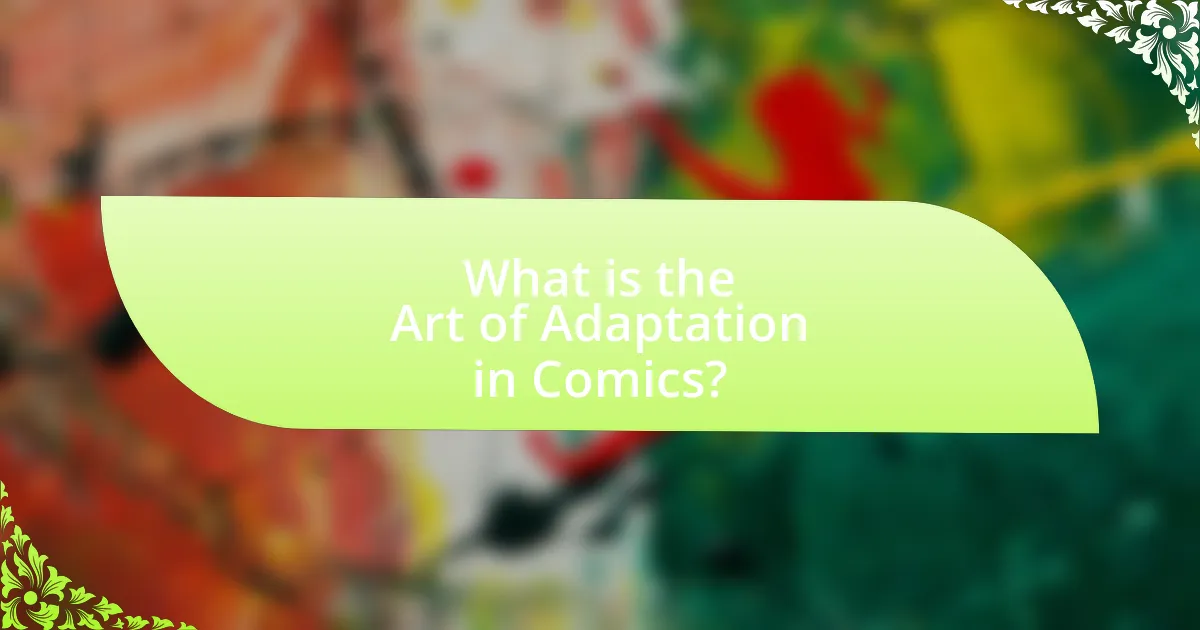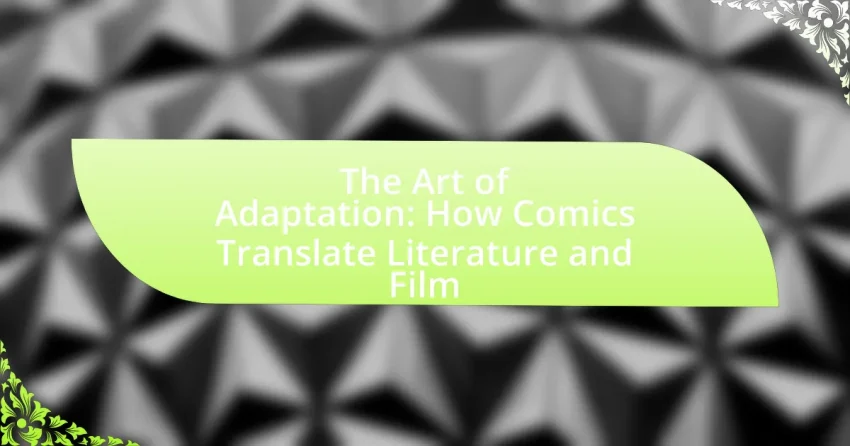The main entity of the article is the process of adaptation in comics, specifically how narratives from literature and film are transformed into the comic medium. The article explores the unique characteristics of comics that facilitate adaptation, such as visual storytelling and sequential art, and discusses the techniques used to convey complex themes and character development. It highlights the cultural significance of adaptations in the comic industry, their impact on audience perception of original works, and the challenges creators face in balancing fidelity to source material with creative interpretation. Additionally, the article examines how comics can expand narratives and reach new audiences, providing best practices for creators in the adaptation process.

What is the Art of Adaptation in Comics?
The Art of Adaptation in Comics refers to the process of transforming narratives from literature or film into the comic medium, utilizing visual storytelling techniques to convey themes, characters, and plots. This adaptation process often involves reinterpreting source material to fit the unique characteristics of comics, such as panel layout, pacing, and visual symbolism. For instance, adaptations like “Maus” by Art Spiegelman and “Watchmen” by Alan Moore demonstrate how comics can effectively capture complex narratives and emotional depth, showcasing the medium’s ability to enhance storytelling through visual elements.
How do comics serve as a medium for adaptation?
Comics serve as a medium for adaptation by transforming narratives from literature and film into a visual format that combines imagery and text. This duality allows for a unique storytelling approach, where visual elements enhance emotional engagement and comprehension of the plot. For instance, adaptations like “Watchmen” and “Maus” illustrate how comics can convey complex themes and character development through both artwork and dialogue, effectively translating the source material’s essence. The sequential art form of comics also allows for pacing control, enabling readers to absorb the story at their own speed, which can deepen their understanding of the adapted content.
What are the unique characteristics of comics that facilitate adaptation?
Comics possess unique characteristics that facilitate adaptation, primarily through their visual storytelling, sequential art, and integration of text and imagery. The visual storytelling allows for immediate emotional engagement, as images can convey complex emotions and actions quickly, making it easier to adapt narratives from literature or film. Sequential art organizes the narrative in a way that guides the reader through the story, enhancing comprehension and pacing, which is crucial when translating longer or more intricate source materials. Additionally, the combination of text and imagery creates a multi-layered experience, allowing for nuanced interpretations and deeper connections to the source material. These characteristics have been evidenced in successful adaptations, such as “Maus” by Art Spiegelman, which effectively translates the Holocaust narrative into a graphic format, demonstrating how comics can encapsulate profound themes while remaining accessible.
How do visual elements enhance storytelling in adaptations?
Visual elements enhance storytelling in adaptations by providing immediate emotional context and visual cues that deepen audience engagement. For instance, color palettes can evoke specific moods; dark tones may signify tension or danger, while bright colors can convey joy or hope. Additionally, visual symbolism, such as recurring motifs or imagery, reinforces themes and character arcs, making complex narratives more accessible. Research indicates that adaptations utilizing strong visual storytelling techniques, like graphic novels or films, often achieve higher audience retention and emotional impact, as seen in adaptations like “Watchmen” and “The Great Gatsby,” where visual elements significantly contribute to narrative depth and viewer connection.
Why is adaptation important in the context of comics?
Adaptation is important in the context of comics because it allows for the reinterpretation and reimagining of existing narratives, making them accessible to new audiences. Comics can distill complex stories into visual formats, enhancing engagement through illustrations and sequential art. For instance, adaptations of literary works, such as “Watchmen,” have introduced intricate themes and characters to readers who may not engage with the original text. This process not only broadens the reach of the source material but also fosters creativity by allowing artists and writers to explore different perspectives and styles, ultimately enriching the comic medium itself.
What cultural significance do adaptations hold in the comic industry?
Adaptations hold significant cultural importance in the comic industry as they bridge diverse narratives across various media, enhancing accessibility and engagement. By transforming literature and film into comic form, adaptations allow for a visual storytelling approach that can reach broader audiences, including those who may not engage with the original formats. For instance, adaptations of classic literature, such as “Pride and Prejudice” or “The Great Gatsby,” have introduced these works to younger generations, fostering literary appreciation. Furthermore, adaptations often reflect contemporary societal issues, making them relevant and relatable, as seen in comics that reinterpret superhero narratives to address themes like identity and justice. This cultural significance is underscored by the commercial success of adaptations, with titles like “The Walking Dead” and “Watchmen” achieving critical acclaim and substantial sales, demonstrating their impact on both the comic industry and popular culture.
How do adaptations influence the perception of original works?
Adaptations significantly influence the perception of original works by altering their narrative, themes, and character interpretations, which can lead to varied audience responses. For instance, when a novel is adapted into a film or comic, the visual representation and pacing can shift the audience’s understanding of the story, emphasizing different aspects than the original text. A notable example is the adaptation of “The Great Gatsby,” where the film’s visual style and soundtrack can evoke emotions that differ from the reader’s experience of the written word. This transformation can enhance or diminish the perceived depth of the original work, as adaptations often prioritize certain elements over others, thereby reshaping the audience’s engagement and interpretation.

How do Comics Translate Literature?
Comics translate literature by visually interpreting narrative elements, character development, and thematic content through sequential art. This medium condenses complex literary themes into accessible visual formats, allowing readers to engage with the story through illustrations and dialogue. For instance, adaptations like “Maus” by Art Spiegelman effectively convey the Holocaust’s emotional weight by combining imagery with text, enhancing the reader’s understanding of the narrative’s gravity. Additionally, comics utilize visual storytelling techniques, such as panel transitions and visual metaphors, to encapsulate literary devices like symbolism and foreshadowing, making literature more approachable for diverse audiences.
What are the common techniques used in literary adaptations to comics?
Common techniques used in literary adaptations to comics include visual storytelling, panel composition, and dialogue condensation. Visual storytelling allows artists to convey narrative elements through imagery, enhancing emotional impact and character development. Panel composition organizes the flow of the story, guiding readers through the narrative arc effectively. Dialogue condensation involves distilling lengthy prose into concise speech bubbles, maintaining the essence of the original text while fitting the comic format. These techniques are essential for translating complex literary themes into a visual medium, ensuring that the adaptation resonates with both existing fans of the literature and new audiences.
How do narrative structures differ between literature and comics?
Narrative structures in literature and comics differ primarily in their use of text and visual elements to convey story. Literature relies on prose to develop characters, settings, and plots through descriptive language, allowing for deep internal monologues and complex narrative arcs. In contrast, comics combine sequential art with minimal text, using visual storytelling to convey action and emotion, often relying on imagery to express what might take pages of text in literature.
For example, a literary work may explore a character’s thoughts over several paragraphs, while a comic can depict the same character’s emotional state through facial expressions and visual cues in a single panel. This visual immediacy allows comics to convey information quickly, often using techniques like panel transitions and visual metaphors that are not available in traditional prose. The interplay of images and text in comics creates a unique rhythm and pacing that differs from the linear progression typically found in literature.
What role does dialogue play in adapting literature to comics?
Dialogue serves as a crucial element in adapting literature to comics by conveying character emotions, advancing the plot, and providing context within a limited visual format. In comics, dialogue must be concise due to space constraints, which necessitates that each line be impactful and meaningful. This compression often enhances the emotional weight of the narrative, as seen in adaptations like “Maus” by Art Spiegelman, where dialogue encapsulates complex themes of trauma and identity in a succinct manner. Furthermore, dialogue in comics complements visual storytelling, allowing for a dynamic interplay between text and imagery that enriches the reader’s experience. This synergy is essential for maintaining the essence of the original literary work while transforming it into a new medium.
What challenges arise when adapting literature into comics?
Adapting literature into comics presents several challenges, primarily related to the condensation of narrative and the visual representation of complex themes. The need to distill extensive prose into concise dialogue and imagery can lead to the loss of nuanced character development and intricate plot details. Additionally, translating literary devices such as internal monologues or descriptive passages into visual formats requires creative interpretation, which may not always resonate with the original intent of the author. Furthermore, the balance between text and illustration is crucial; excessive text can overwhelm the visuals, while too little can leave the story underdeveloped. These challenges necessitate a careful approach to ensure fidelity to the source material while effectively utilizing the unique strengths of the comic medium.
How do creators balance fidelity to the source material with creative interpretation?
Creators balance fidelity to the source material with creative interpretation by carefully analyzing the core themes and character motivations of the original work while allowing for innovative storytelling techniques. This approach enables them to maintain the essence of the source material, ensuring that key elements resonate with audiences, while also adapting the narrative to fit the unique medium of comics. For instance, adaptations like “Watchmen” by Alan Moore and Dave Gibbons preserve the philosophical underpinnings of the original graphic novel while employing visual storytelling to enhance emotional impact. This method demonstrates that successful adaptations can honor the source material while also embracing creative freedom, ultimately enriching the audience’s experience.
What are the limitations of comics as a medium for literary adaptation?
Comics have limitations as a medium for literary adaptation primarily due to their reliance on visual storytelling, which can restrict the depth of narrative and character development. The visual format often necessitates simplification of complex themes and internal monologues, as seen in adaptations like “Watchmen,” where the intricate philosophical discussions in the original novel are condensed into visual panels. Additionally, the pacing in comics can differ significantly from prose, potentially leading to a loss of nuance and emotional resonance, as illustrated in adaptations such as “The Great Gatsby,” where the richness of Fitzgerald’s language is difficult to capture in a limited number of frames. Furthermore, the audience’s interpretation is influenced by the artwork, which can overshadow the original text’s intent, as evidenced in adaptations like “Maus,” where the visual representation of trauma may alter the reader’s perception of the narrative.

How do Comics Translate Film?
Comics translate film by adapting visual storytelling techniques and narrative structures to create a new medium that retains the essence of the original film. This process often involves selecting key scenes, dialogue, and character designs from the film to convey the story visually through panels and illustrations. For example, the comic adaptation of “The Dark Knight” captures the film’s tone and character dynamics while utilizing the unique pacing and visual style that comics offer. This method allows for a reinterpretation of cinematic elements, such as framing and perspective, which can enhance the audience’s engagement with the story.
What are the key differences between adapting film to comics versus literature?
Adapting film to comics differs from adapting film to literature primarily in visual representation and narrative structure. Comics utilize sequential art and visual storytelling, requiring a focus on imagery, panel layout, and pacing to convey action and emotion, while literature relies on descriptive language and internal monologue to develop characters and plot. For instance, a film adaptation into comics must translate visual scenes into static images, often condensing dialogue and action into fewer frames, whereas literature adaptations can expand on themes and character thoughts through detailed prose. This distinction highlights the necessity for different creative approaches in each medium, as comics prioritize visual engagement while literature emphasizes narrative depth.
How do pacing and visual storytelling differ in film adaptations to comics?
Pacing in film adaptations differs from comics primarily due to the time constraints and narrative flow inherent in each medium. Films typically condense storylines to fit within a two-hour runtime, leading to faster pacing and a focus on visual spectacle, while comics allow for a more leisurely exploration of plot and character through sequential art, enabling readers to control their reading speed.
Visual storytelling also varies significantly; films rely on cinematography, editing, and sound to convey emotions and themes, whereas comics utilize static images, panel layouts, and visual cues to guide the reader’s interpretation. For instance, a comic can use varying panel sizes and arrangements to create tension or emphasize moments, while a film may employ quick cuts or sweeping camera movements to achieve similar effects. This fundamental difference in how each medium communicates narrative and emotion underscores the unique strengths and limitations of film and comics in storytelling.
What techniques are used to convey cinematic elements in comic form?
Techniques used to convey cinematic elements in comic form include panel transitions, visual storytelling, and the use of cinematic framing. Panel transitions, such as cuts, fades, and dissolves, mimic film editing techniques, allowing readers to experience time and motion similarly to watching a movie. Visual storytelling relies on imagery and composition to convey emotions and actions without dialogue, paralleling how films use visuals to tell a story. Cinematic framing, including close-ups and wide shots, enhances the narrative by focusing on specific details or providing context, akin to how filmmakers use camera angles to guide viewer perception. These techniques collectively create a dynamic reading experience that reflects cinematic storytelling.
What are the benefits of adapting films into comics?
Adapting films into comics offers several benefits, including the ability to reach a broader audience and provide a new medium for storytelling. Comics can visually represent scenes and characters, allowing for a different interpretation of the narrative that can engage readers in unique ways. Additionally, the comic format can condense complex plots into more digestible segments, making the story accessible to those who may not watch the film. This adaptation process can also expand the universe of the original film, introducing new characters or subplots that enhance the overall experience. Furthermore, comics can serve as a promotional tool for films, generating interest and excitement prior to a movie’s release.
How do comics expand on the narratives presented in films?
Comics expand on the narratives presented in films by providing additional context, character development, and backstory that may not be fully explored in the cinematic version. For instance, comic adaptations often delve deeper into a character’s motivations and histories, allowing readers to gain a more nuanced understanding of their actions and relationships. A notable example is the “Watchmen” graphic novel, which includes extensive character backstories and subplots that enrich the film’s narrative, offering insights into the complex world and its characters that the film could only hint at. This additional content enhances the overall storytelling experience, making the narrative more layered and engaging for the audience.
What new audiences can be reached through comic adaptations of films?
Comic adaptations of films can reach younger audiences, particularly children and teenagers, who are more engaged with visual storytelling. This demographic often prefers comics due to their accessible format and vibrant illustrations, which can simplify complex narratives. Additionally, comic adaptations can attract readers who may not typically watch films, such as avid comic book fans or those interested in graphic novels, expanding the audience base beyond traditional moviegoers. The success of adaptations like “Scott Pilgrim vs. The World” demonstrates how comics can bridge the gap between different media, drawing in diverse groups who appreciate both the original film and the comic format.
What best practices should creators follow when adapting literature and film into comics?
Creators should prioritize fidelity to the source material while also embracing the unique strengths of the comic medium when adapting literature and film into comics. This involves distilling the narrative to its core elements, ensuring that key themes and character arcs are preserved, while also utilizing visual storytelling techniques such as panel layout, pacing, and artistic style to enhance the narrative. For instance, the graphic novel adaptation of “Watchmen” by Alan Moore and Dave Gibbons effectively captures the complex themes of the original comic while employing innovative visual techniques that leverage the medium’s strengths. Additionally, creators should consider the target audience and the intended emotional impact, tailoring the adaptation to resonate with readers familiar with the source material as well as those encountering the story for the first time.
